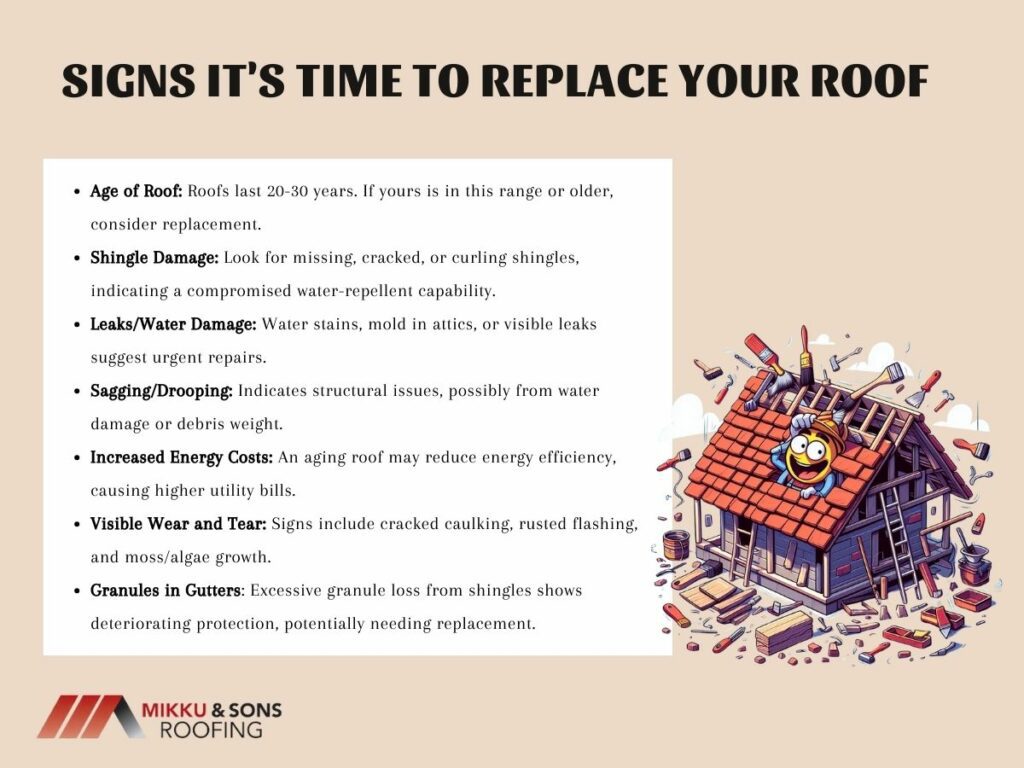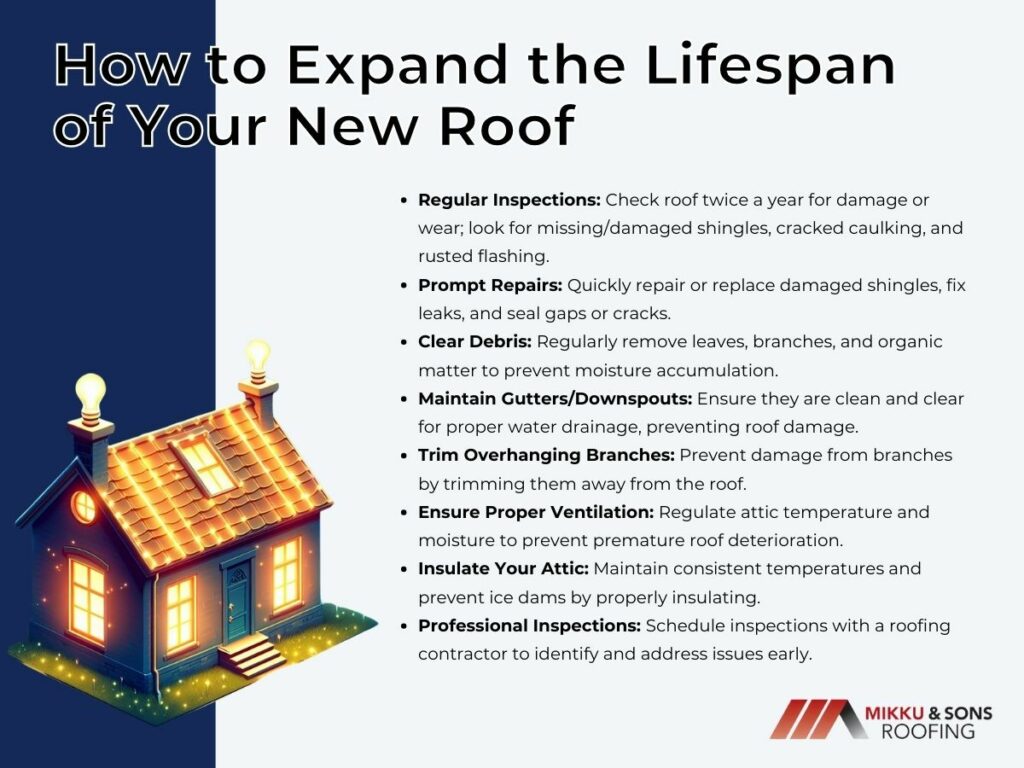

Your roof serves as the first line of defense against the elements, enduring scorching sun, pounding rain, biting wind, and heavy snow. Over time, wear and tear can weaken its defenses, potentially leading to costly damage if ignored.
Recognizing when to replace your roof is essential for safeguarding your investment and preserving your home's integrity. While regular maintenance and repairs can extend its lifespan, there comes a point when replacement becomes necessary.
In this article, we'll explore seven unmistakable signs indicating it's time for a roof replacement. These warning signals, from visible damage to hidden vulnerabilities, offer valuable insights into your roof's condition, aiding informed decisions about maintenance and upkeep.
Recognizing the right time to replace your roof is crucial for upholding your home's integrity and preventing expensive repairs. Here are seven clear indicators that suggest it's time to consider investing in a roof replacement.

Roofs typically have a lifespan of 20 to 30 years, depending on the materials used and environmental factors. If your roof is nearing or has exceeded this age range, it's a clear indication that replacement is due, regardless of visible damage.
Inspect your roof for missing, cracked, or curling shingles. Damaged shingles compromise your roof's ability to repel water, increasing the risk of leaks and further deterioration.
Water stains on ceilings or walls, mold growth in attics, and signal roof leaks that require immediate attention. Ignoring these issues can lead to extensive damage to your home's interior structure.
A sagging roof indicates structural issues, potentially caused by water damage or the weight of debris. If you notice any sagging or drooping areas, it's crucial to have your roof inspected promptly.
An aging roof can reduce your home's energy efficiency, resulting in higher heating and cooling bills. If you've noticed a significant increase in energy costs, your roof may be due for replacement.
Check for signs of wear and tear, such as cracked caulking, rusted flashing, or moss and algae growth. These issues can indicate underlying problems that may worsen over time.
Excessive granule loss from asphalt shingles suggests that your roof's protective surface is deteriorating. This compromises its ability to withstand weather conditions and may necessitate replacement.
By addressing these telltale signs promptly, you can avoid costly damage and ensure the long-term durability of your home. If you need clarification on the condition of your roof, consult with a professional roofing contractor for an assessment and recommendations.
When replacing your roof, several important factors should be considered to ensure a successful and long-lasting installation. These factors include:
Choose the appropriate roofing material based on factors such as durability, aesthetics, climate suitability, and budget. Common options include asphalt shingles, metal roofing, tile, wood shakes, and synthetic materials.
Selecting a reputable and experienced roofing contractor is essential for a quality installation. Research potential contractors, check their credentials, read reviews, and request quotes from multiple companies before making a decision.
Familiarize yourself with local building codes, regulations, and permit requirements for roof replacements in your area. Ensure that your roofing project complies with all necessary regulations to avoid potential fines or legal issues.
Consider the architectural style of your home and choose a roofing design and color that complements its aesthetic appeal. Consult with your roofing contractor to explore different design options and find the best fit for your home.
Proper ventilation and insulation are crucial for maintaining energy efficiency and preventing moisture buildup in your attic. Discuss ventilation and insulation options with your contractor to ensure optimal performance and comfort.
Determine your budget for the roof replacement project, including material costs, labor expenses, and any additional fees. Explore financing options, such as loans or payment plans, if needed, to help cover the upfront costs of the project.
Inquire about warranties offered by the roofing manufacturer and contractor, including coverage for materials and workmanship. Additionally, discuss ongoing maintenance requirements and schedule periodic inspections to prolong the lifespan of your new roof.
Consider the weather and timing of your roof replacement project to minimize disruptions and ensure optimal conditions for installation. Plan the project during a time of year with favorable weather conditions and allow sufficient time for completion.
By carefully considering these factors and working closely with your roofing contractor, you can ensure a successful and satisfactory roof replacement that enhances the beauty, functionality, and value of your home.
Selecting the right roofing material is crucial for the durability, aesthetics, and performance of your roof. Here are some recommended roofing materials based on various factors:
When choosing a roofing material, consider factors such as climate, budget, aesthetic preferences, durability, and maintenance requirements. Consult with a roofing professional to determine the best option for your specific needs and preferences.
Expanding the lifespan of your new roof requires proactive maintenance and careful attention to various factors that can affect its longevity. Here are some tips to help you maximize the lifespan of your roof:

Conduct regular visual inspections of your roof, ideally twice a year, to check for signs of damage, wear, or deterioration. Look for missing or damaged shingles, cracked caulking, rusted flashing, and any other issues that may require attention.
Address any roofing issues promptly to prevent them from worsening and causing further damage to your roof and home. Repair or replace damaged or missing shingles, fix leaks, and seal any gaps or cracks in the roof as soon as they are identified.
Keep your roof clear of debris, such as leaves, branches, and other organic matter that can accumulate and trap moisture. Remove debris regularly to prevent water from pooling and causing damage to the roof structure and materials.
Clean and inspect your gutters and downspouts regularly to ensure proper drainage and prevent water from backing up and damaging your roof. Remove leaves, dirt, and debris from gutters and downspouts to prevent clogs and water buildup.
Trim back overhanging branches from trees near your roof to prevent them from rubbing against or falling onto the roof during storms or high winds. Branches can cause damage to shingles, gutters, and other roofing components if left unchecked.
Proper attic ventilation is essential for regulating temperature and moisture levels in your attic space, which can affect the lifespan of your roof. Ensure that your attic is adequately ventilated to prevent moisture buildup and heat buildup, which can lead to premature roof deterioration.
Proper attic insulation helps maintain consistent indoor temperatures, reducing the workload on your HVAC system and preventing ice dams from forming on the roof during winter. Adequate insulation also helps prevent heat from escaping through the roof, reducing the risk of snow melting and refreezing, which can cause damage to shingles and gutters.
Hire a professional roofing contractor to perform periodic inspections of your roof to assess its condition and identify any potential issues that may need attention. Professional inspections can help catch problems early and extend the lifespan of your roof.
By following these tips and investing in regular maintenance and inspections, you can help extend the lifespan of your new roof and protect your home for years to come.
Your roof serves as a critical barrier against the elements, safeguarding your home and family. Over time, wear and tear can compromise its effectiveness, necessitating replacement to preserve your home's integrity and avoid costly damage.
By recognizing the signs indicating the need for a replacement and carefully considering factors such as materials, contractor selection, regulations, design, and maintenance, you can ensure a successful roof replacement project.
Additionally, implementing proactive measures to extend the lifespan of your new roof, such as regular inspections, prompt repairs, and proper maintenance, will further protect your investment and provide peace of mind for years to come. With careful planning and attention to detail, you can ensure that your home remains secure and protected with a durable and long-lasting roof.
